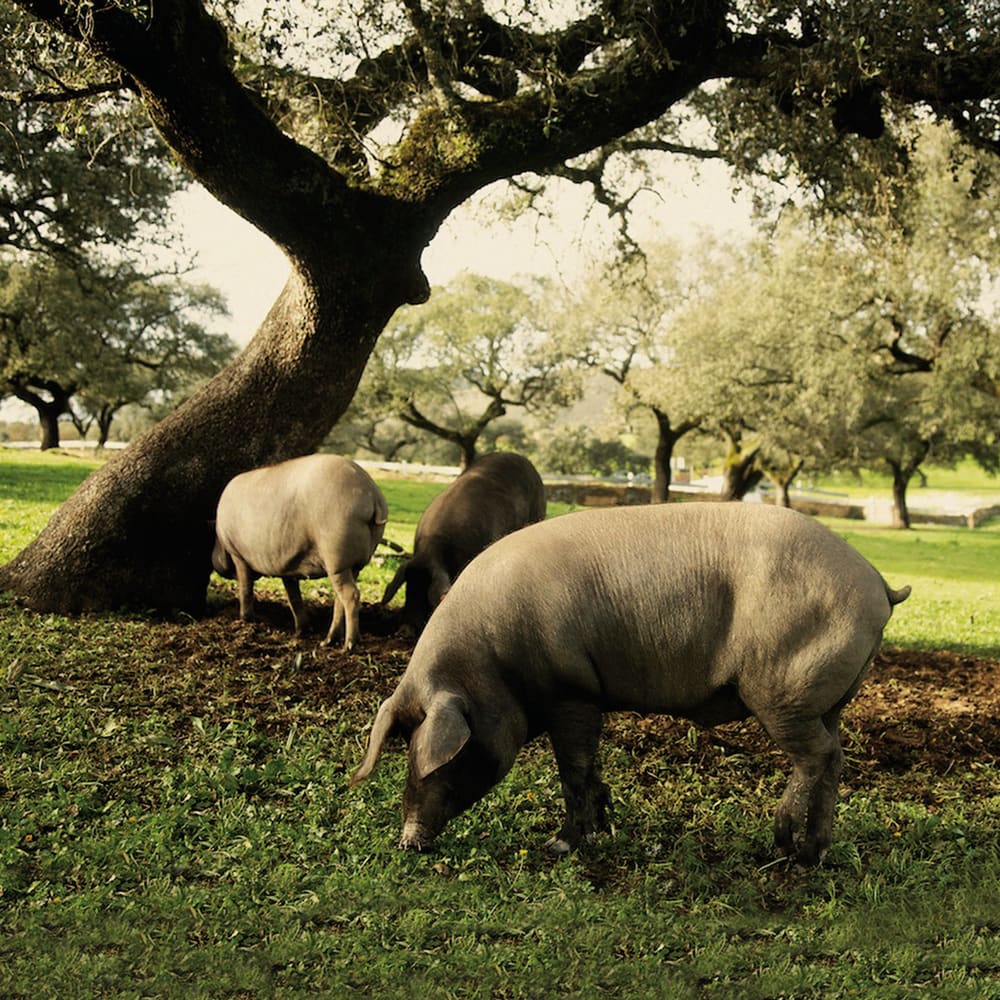The Pig Breeds
July 2024


White pigs, which populate all of Europe, are the source of Jamón Serrano. Those bred in Spain are close relatives to those throughout neighboring countries throughout the European Union. Some of the most familiar breeds are Duroc, Pietrain and Landrace.
The Cerdo Ibérico has a lineage which reaches back to the time of the cavemen of the Iberian Peninsula. The Ibérico is a strain of pig that varies significantly from pigs found elsewhere.
This is a rare breed, found only in Spain. They are either grain fed to create Jamón Ibérico or free range on the Dehesa rangeland, source of the finest Jamón Ibérico de Bellota hams.
Without the Dehesa there are no Ibérico de Bellota hams. The unique genetic structure of the animal and its diet yield a ham that is more thoroughly marbled than a white pig. The acorn diet contributes to its rich and nutty flavor.
Ibérico pigs are divided into black (Entrepelado, Lampiño, Mamellado, Silvela and Negro de los Pedroches), red (Retinto, Colorado, Oliventina and Torbiscal), spotted (Manchado de Jabugo), and light-skinned Ibérico pigs (Dorado Gaditano), although these light-skinned Ibérico pigs are nearly extinct.
Since pre-history, the Ibérico breed has lived in free-range conditions, mainly in the rangeland of western Spain along the Portuguese border, but also in parts of Andalucía near Cordoba. The Ibérico pig has dark skin with a sparse coat, a pointed snout and long, slender legs.
The most common crossbreed is between Retintos or Lampiños Ibérico pigs and Duroc-Jersey white pigs. Although you might think that a purebred Ibérico pig would produce the finest Jamón Ibérico, cross breeding makes a more balanced fat to lean ratio -- up to a point.
Careful breeders are careful to keep the proportion of Ibérico stock above 75%, because that is the minimum required by the four Denominations of Origin for Ibérico pigs. This guarantee is why many feel that the designated D.O. is crucial to the consumer.
Mangalica pigs are also used to produce hams in Spain. They are a Hungarian breed that is a distant relative of the Ibérico pig. It has amusingly curly hair, making it look somewhat like a sheep.
The Mangalica has the highest percentage of fat among pigs raised in Spain. This fat content makes its hams and loins mature very slowly into a ham with exceptionally rich aromas and flavor. Mangalica production is very limited, and the breed has been in danger of becoming extinct.
One of the most important factors in determining the quality and characteristics of the resulting ham is the breed of the pig, especially in determining the way the fat is distributed in the ham.
Ibérico pigs yield hams that are streaked with glossy marbling fat. One of the distinctive genetic traits of this breed is its ability to store fat in muscle tissue, the key to the unmistakable flavor and texture of Ibérico hams. The hams from these pigs are known as Jamón Ibérico.
The Ibérico hams are characteristically long and slender. The hoof is dark, and the color of the flesh ranges from rosy to a deep purplish crimson. The texture of the ham is remarkably soft. Due to high percentage of healthy mono unsaturated fat within the meat, slices of Ibérico Bellota glisten when served at room temperature. The melting point of the fat is about 70 degrees Fahrenheit.
Ibérico ham is also popularly known as ‘Pata Negra’ (black hoof) because the skin and hoof of an Ibérico hog tend to be black. This can be a confusing term because there are varieties of Ibérico pigs that are not black. Conversely, there are also pigs that are not of the Ibérico blood line with black or very dark hides.
White pigs yield Jamón Serrano (or Serrano ham) that is generally leaner than those produced by their distant Ibérico cousins. They carry their fat on the outside of the ham rather than heavily marbled within the muscles. Serrano hams tend to be uniform in size, with reddish meat and white or slightly yellowish fat. The meat of Serrano hams is more salty than Ibérico hams and has a mild aroma.

